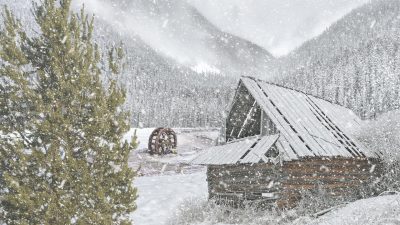The Forgotten Disaster That Devastated Tajikistan
The 1949 Khait Landslide ranks among the deadliest yet least discussed natural disasters in history. This catastrophic event struck the mountainous regions of Tajikistan, erasing entire villages in an instant. Despite the massive loss of life and widespread destruction, the tragedy remains largely overlooked on a global scale. This article explores the causes, impact, and long-term consequences of this devastating landslide.
The Deadly Trigger: How a Powerful Earthquake Set Off the Khait Landslide
On 10th July 1949, a violent earthquake, registering approximately 7.4 on the Richter scale, shook Tajikistan. The epicentre, located in the Gissar-Kokshaaltau range, caused severe tremors that destabilised the already fragile mountains. The quake dislodged enormous rock masses, unleashing an unstoppable torrent of debris that thundered down the slopes.
Entire villages were swallowed within seconds, giving residents no chance to escape. In the days that followed, aftershocks and secondary landslides compounded the devastation, further worsening the humanitarian crisis. The combination of seismic activity and unstable geology led to one of the worst landslide disasters ever recorded.
Death and Destruction: The Unimaginable Human Cost
- Catastrophic Death Toll: Official figures estimate that more than 28,000 people perished, ranking the disaster among the deadliest landslides in history. Given the remoteness of the region, some experts believe the true casualty count may have been even higher.
- Entire Settlements Obliterated: Villages, including Khait, were completely buried beneath millions of cubic metres of rock and debris. Survivors described a barren landscape where homes, roads, and entire communities had vanished without a trace.
- Thousands Left Without Homes: Those who managed to survive were left destitute, having lost their families, shelters, and livelihoods. With no immediate relief response, they faced an uncertain future.
Could the Khait Landslide Have Been Prevented?
Although earthquakes occur naturally, the sheer scale of devastation raises concerns about whether warning signs were ignored. Experts suggest that long-term erosion and deforestation had already weakened the terrain, making the area susceptible to landslides. The absence of monitoring and preparedness left local communities exposed to an unavoidable catastrophe.
Additionally, inadequate infrastructure and a lack of emergency response planning contributed to the immense death toll. With better disaster risk management, lives could potentially have been saved. However, in 1949, limited scientific understanding of seismic activity and landslides left authorities powerless to intervene effectively.
The Aftermath: A Struggle for Survival and Recovery
The aftermath of the disaster saw widespread devastation, with thousands in desperate need of assistance. Rescue operations were hindered by the magnitude of destruction and the lack of proper resources. Landslide debris blocked crucial roads, delaying aid efforts and leaving many stranded without help.
For those who survived, the ordeal was far from over. Many were forced to relocate, abandoning the only homes they had ever known. Others attempted to rebuild amidst the ruins, but the economic and emotional toll of the catastrophe lingered for decades. Even today, the scars of the 1949 disaster continue to shape the region.
Nature’s Wrath or Human Failure? The Debate Over the Landslide’s Causes
Although the earthquake was the immediate trigger, human actions may have exacerbated the disaster. Research suggests that extensive deforestation and unsustainable land use had already destabilised the slopes. When the tremors struck, the already weakened land had little resistance left.
Furthermore, the absence of geological studies and early warning systems meant that communities unknowingly lived in hazardous zones. Could better environmental policies and stronger infrastructure have mitigated the destruction? While debatable, it is clear that both natural forces and human negligence played a role in this catastrophic event.
Why the Khait Landslide Remains Largely Overlooked
- Minimal International Coverage: Unlike other large-scale disasters, the Khait Landslide did not receive significant global media attention. At the time, Tajikistan was under Soviet rule, and information about the catastrophe was not widely disclosed.
- Limited Scientific Research: Due to restricted access to the affected region and political constraints, few comprehensive studies were conducted, leaving gaps in our understanding of the disaster.
- Overshadowed by Other Events: The mid-20th century saw numerous significant global disasters, causing the Khait tragedy to fade into obscurity outside Tajikistan.
Could a Disaster Like the 1949 Landslide Happen Again?
Tajikistan remains highly vulnerable to landslides due to its seismic activity and mountainous landscape. Despite advancements in disaster management and early warning systems, challenges persist. Many remote areas still lack proper monitoring, and climate change has further destabilised the environment.
The 1949 Khait Landslide serves as a stark reminder of what can happen when natural disasters strike unprepared regions. Investing in robust infrastructure, environmental conservation, and scientific research is critical to preventing history from repeating itself.
Conclusion: The Importance of Remembering the Khait Landslide
The Khait Landslide of 1949 was an unparalleled tragedy, yet it remains relatively unknown outside Tajikistan. The enormous loss of life and the long-lasting impact highlight the need for better disaster preparedness. By studying past catastrophes, future generations can learn vital lessons and work towards creating safer, more resilient communities.
FAQs About the Khait Landslide, 1949
- What caused the Khait Landslide?
- A major earthquake triggered the landslide, burying entire settlements under tonnes of debris.
- How many people lost their lives?
- Official records estimate over 28,000 fatalities, though the actual number may have been higher.
- Which areas suffered the worst impact?
- The Khait region and its neighbouring villages were almost completely destroyed.
- Could this disaster have been prevented?
- While the earthquake was unavoidable, poor land management and lack of preparedness increased the devastation.
- Is Tajikistan still at risk of similar disasters?
- Yes, due to its seismic activity and unstable terrain, the country remains prone to landslides, underscoring the need for improved mitigation measures.
Reference:
Khait Landslide – Wikipedia
On the Loss of Life in Landslides During the 1949 Khait Earthquake – AGU Blogosphere
The Tragedy of Khait: A Natural Disaster in Tajikistan – BioOne




